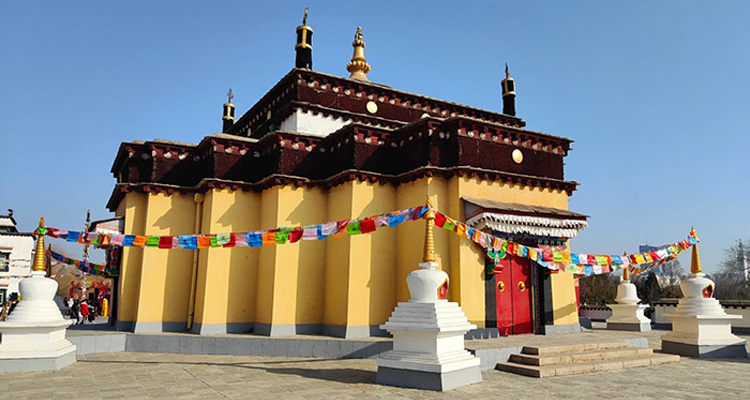Beijing Ethnic Museum & Culture Park: Tour Through China’s 56 Cultures
Nestled in the bustling area of Beijing’s North Fourth Ring Road lies a magical place where you can “travel across all of China in just one day” — the Beijing Chinese Ethnic Culture Park (also known as the Chinese Ethnic Museum). As China’s first large-scale anthropological museum, this 50-hectare park feels like a living encyclopedia of ethnic culture, vividly recreating the lives, homes, and customs of China’s 56 ethnic groups. Stroll through leafy paths and you’ll suddenly find yourself standing before a Tibetan white stupa, a Dai bamboo house from Yunnan, or a Mongolian yurt on the grasslands — as if you’ve traveled thousands of miles in just a few steps.

1. Why This Park Deserves a Spot on Your Travel List
The park’s story began in 1992, led by chief designer Wang Ping. The North Garden opened in June 1994, followed by the South Garden in September 2001. It was a major cultural project listed in Beijing’s “Eighth Five-Year Plan” and the celebrations of the PRC’s 50th anniversary, with an investment of 800 million RMB — filling the gap of China not having a large anthropological museum.
What makes this place truly unique is its authentic recreations. All ethnic architecture is built at 1:1 scale, with many structures crafted by artisans using original materials and traditional techniques. Some houses were even relocated entirely from ethnic regions and rebuilt here in Beijing. This dedication to detail transforms the park into more than a tourist attraction — it’s a living museum of ethnic cultures.
As a National 4A Tourist Attraction, the park blends nature and culture seamlessly. You’ll find tropical banyan forests, underground caves, earth pillars, waterfalls, and even cliff paintings that complement the ethnic villages, showcasing the harmony between people and nature.

2. What You’ll See Here
Authentic Ethnic Architecture
The park is divided into North and South Gardens. The North Garden features 16 ethnic villages, including Tibetan, Miao, Yi, Dong, Taiwanese Gaoshan, and Korean. The South Garden highlights the Ethnic Museum, Sculpture Square, and over 20 more villages. Each village is a detailed recreation of daily life and cultural traditions:
- Tibetan Area: Complete with Barkhor Street residences, Jokhang Temple’s golden roof, and spinning prayer wheels — you’ll feel transported to the high plateau.
- Dai Wind-and-Rain Bridge and Manfeilong Pagoda: Bringing vibrant tropical vibes.
- Dong Drum Tower: A towering symbol of Dong craftsmanship.
- Miao Stilt Houses: Blending harmoniously into the surrounding mountains and rivers.
Cultural Performances and Festivals
Throughout the villages, you’ll encounter lively performances of singing, dancing, weaving, dyeing, and more. Over ten ethnic performance groups bring the park to life with music, crafts, and traditional games.
Seasonal festivals add even more charm: the Dai Water Splashing Festival, the Yi Torch Festival, and the Tibetan Ongkor Festival are just a few. The grand “Ethnic Costume Parade,” featuring hundreds in dazzling traditional attire, is a must-see — like a moving museum of fashion.
Traditional Craftsmanship
Discover rare skills like Miao silver engraving or Tujia weaving. Visitors can also join in hands-on activities, such as Yi lacquer painting or trying on Mongolian wrestling gear.

3. Smart Touring Tips
Suggested Route
For first-time visitors, the North Garden is the best starting point. Enter through the North Gate, begin with the awe-inspiring Tibetan area, then wander to the Dai Bridge, Mongolian yurts, Manchu courtyard, and Yi Torch Square, ending at the Korean residences and central tower. This route offers a compact yet rich experience.
Time Planning
- Quick Visit: 2–3 hours for highlights.
- Deep Dive: 3–4 hours for a relaxed pace with performances and interactive activities.
Helpful Tips
- Food stalls serving ethnic snacks and fast food are available.
- The park is wheelchair and stroller friendly, with wide flat roads.
- Bring a camera — the mix of architecture and nature is a photographer’s dream.
- Check the daily performance schedule in advance to avoid missing out on shows.

4. Location and Getting There
Address
The park is located at No. 1 Minzu Yuan Road, Chaoyang District, Beijing, just southwest of the Olympic Park, near Century Avenue. It’s surrounded by major roads like the North Third and Fourth Ring Roads, making it very accessible.
Public Transport (Recommended)
- Subway: Take Line 8 to Olympic Sports Center Station, Exit D, then walk 5–10 minutes.
- Bus: Routes 113, 607 stop nearby, or take 345, 55, 315, 695 to Qijiahuozi Station and walk east.
By Car
Navigate to “Chinese Ethnic Culture Park.” Accessible via Beichen Road, Beitucheng Road, or the Jingchang Expressway. A 10,000-square-meter parking lot is available.
Nearby Attractions
Since it’s inside the Olympic Park area, you can also visit the Bird’s Nest Stadium, Water Cube, China Science and Technology Museum, or Beichen Central Park for a full day of sightseeing.

5. Tickets and Opening Hours
Ticket Prices
- North Garden Adult: 45 RMB
- South Garden Adult: 68 RMB (Mon–Thu)
- Combined Ticket: 90 RMB
- Discounted Tickets: Available for students, seniors (60+), and people with disabilities (check official rates).
Booking
Tickets can be purchased on-site or via major travel platforms. Foreign visitors follow the same ticketing system as locals.

Opening Hours
- Daily: 08:30–18:00
- Last Entry: 17:00
Reservations
Currently, no reservations are required. On holidays, crowds may be larger, so check announcements in advance.

Visiting the Chinese Ethnic Culture Park is like opening a pop-up book of China’s diverse cultures. Every building tells a story, and every performance reflects a way of life. Whether you’re a culture buff, a photography enthusiast, or just seeking a unique Beijing adventure, this park is guaranteed to broaden your horizons with its rich and colorful heritage.


